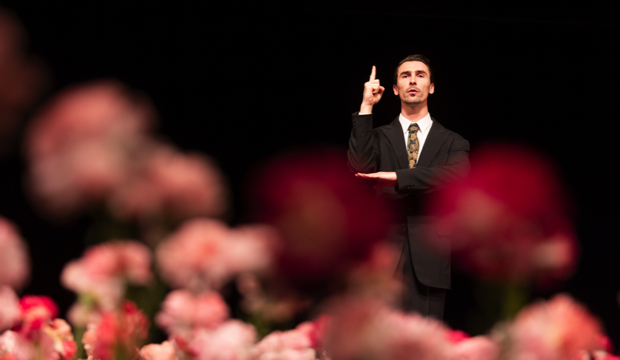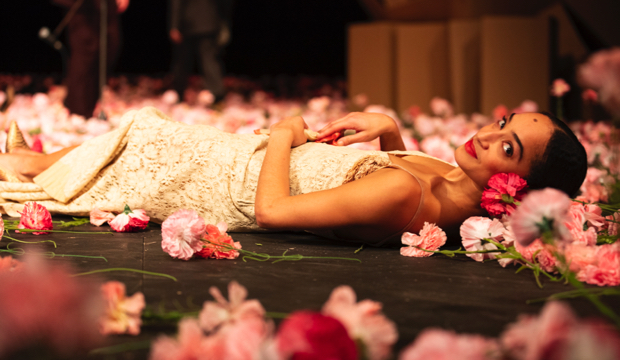Pina Bausch, Nelken Review ★★★★★
On a stage carpeted with 8,000 silk carnations, the dancers of Tanztheater Wuppertal Pina Bausch re-enact her thrilling 1982 classic Nelken at Sadler's Wells
Nelken. Daners Andrey Berezin, Julian Stierle, Reginald Lefebvre. Photo; Evangelos Rodoulis
If you expect linear, coherent narrative, Pina Bausch is not for you. If, on the other hand, you are prepared to surrender to seemingly chaotic, but in fact tightly controlled goings on on stage, your enjoyment growing with every scene, Nelken (carnations) is very much your show.
The late German choreographer Pina Bausch (1940-2009) created a unique body of work, much copied but never equalled, for her Tanztheater Wuppertal Pina Bausch. Nelken, which dates from 1982, is one of her most striking pieces, combining a stage carpeted with 8,000 pink silk carnations (stage design by Peter Pabst), four intimidating Alsatian dogs, two vast scaffolding towers, four stuntmen and, of course, 16 dancers minutely attuned to Bausch’s very specific performance demands.
German expressionism pervades her work, punctuated by memories from her childhood in post-war Germany together with the thoughts and feelings of each of her dancers, to whom she set questions and tasks before assembling the work.
Nelken blends gestures of innocent enjoyment with references to the country's brutal past. Mixing dance routines with the spoken word and ritualised games, Nelken portrays the pain of being bullied and oppressed in sequences that can be deeply disturbing, for example, a woman being force-fed food she hates.
Childhood games, such as grandmother’s footsteps, soon loose their innocence in the face of the leader’s ever more random dictatorial commands. Barking dogs stand to attention as individuals are asked for their passports and undergo a series of humiliations to get them back.
Amid all the mayhem there are scenes of serene beauty. One dancer, Reginald Lefebvre, stands centre-stage translating into universal sign language the lyrics of Gershwin’s The Man I Love.

Nelken, Dancer Reginal Lefebvre. Photo: Oliver Look
Gerwshiin's piece works as a kind of leit motif throughout Nelken as part of an eclectic soundscore that includes songs from the 1930s and 40s alongside snatches of Schubert, Lehár, and Richard Tauber.
Pina Bausch’s signature parade, in this case a gestural depiction of the seasons, is mesmerising with the dancers slowly wending their way over a now fairly messed up carpet of carnations.
Coming towards the end, it contrasts with the preceding scenes were some of the dancers plunge their faces into a pile of just chopped onions, and an older dancer, sitting with her back to us, faces the increasingly threatening physicality of four grim stuntmen jumping on and off a table which they bring ever closer.
Interludes of collective dance, in unison or counterpoint, bring a kind of order to the prevailing disorder, visually denoted also by the men’s costumes, that change from severe black suits to colourful, ill-fitting satin dresses (costume design by Marion Cito).
Throughout, the dancers keep their eyes on the public, demanding engagement and complicity.

Nelken, Dancer Letizia Galloni © Paul Andermann
Since Bausch’s death, Tanztheater Wuppertal Pina Bausch has dedicated itself to keeping her legacy alive. Currently under the directorship of the French maverick Boris Charmatz, with + Terroir Boris Charmatz added to its name, it’ll pair performances of his equally sui generis work with pieces by Bausch. Whether that’ll prove an easy partnership we will soon find out.
The late German choreographer Pina Bausch (1940-2009) created a unique body of work, much copied but never equalled, for her Tanztheater Wuppertal Pina Bausch. Nelken, which dates from 1982, is one of her most striking pieces, combining a stage carpeted with 8,000 pink silk carnations (stage design by Peter Pabst), four intimidating Alsatian dogs, two vast scaffolding towers, four stuntmen and, of course, 16 dancers minutely attuned to Bausch’s very specific performance demands.
German expressionism pervades her work, punctuated by memories from her childhood in post-war Germany together with the thoughts and feelings of each of her dancers, to whom she set questions and tasks before assembling the work.
Nelken blends gestures of innocent enjoyment with references to the country's brutal past. Mixing dance routines with the spoken word and ritualised games, Nelken portrays the pain of being bullied and oppressed in sequences that can be deeply disturbing, for example, a woman being force-fed food she hates.
Childhood games, such as grandmother’s footsteps, soon loose their innocence in the face of the leader’s ever more random dictatorial commands. Barking dogs stand to attention as individuals are asked for their passports and undergo a series of humiliations to get them back.
Amid all the mayhem there are scenes of serene beauty. One dancer, Reginald Lefebvre, stands centre-stage translating into universal sign language the lyrics of Gershwin’s The Man I Love.

Nelken, Dancer Reginal Lefebvre. Photo: Oliver Look
Gerwshiin's piece works as a kind of leit motif throughout Nelken as part of an eclectic soundscore that includes songs from the 1930s and 40s alongside snatches of Schubert, Lehár, and Richard Tauber.
Pina Bausch’s signature parade, in this case a gestural depiction of the seasons, is mesmerising with the dancers slowly wending their way over a now fairly messed up carpet of carnations.
Coming towards the end, it contrasts with the preceding scenes were some of the dancers plunge their faces into a pile of just chopped onions, and an older dancer, sitting with her back to us, faces the increasingly threatening physicality of four grim stuntmen jumping on and off a table which they bring ever closer.
Interludes of collective dance, in unison or counterpoint, bring a kind of order to the prevailing disorder, visually denoted also by the men’s costumes, that change from severe black suits to colourful, ill-fitting satin dresses (costume design by Marion Cito).
Throughout, the dancers keep their eyes on the public, demanding engagement and complicity.

Nelken, Dancer Letizia Galloni © Paul Andermann
Since Bausch’s death, Tanztheater Wuppertal Pina Bausch has dedicated itself to keeping her legacy alive. Currently under the directorship of the French maverick Boris Charmatz, with + Terroir Boris Charmatz added to its name, it’ll pair performances of his equally sui generis work with pieces by Bausch. Whether that’ll prove an easy partnership we will soon find out.
TRY CULTURE WHISPER
Receive free tickets & insider tips to unlock the best of London — direct to your inbox
| What | Pina Bausch, Nelken Review |
| Where | Sadler's Wells, Rosebery Avenue, London, EC1R 4TN | MAP |
| Nearest tube | Angel (underground) |
| When |
14 Feb 24 – 22 Feb 24, 19:30 Dur.: 1 hour 50 mins no interval |
| Price | £15-£85 (+booking fee) |
| Website | Click here to book |